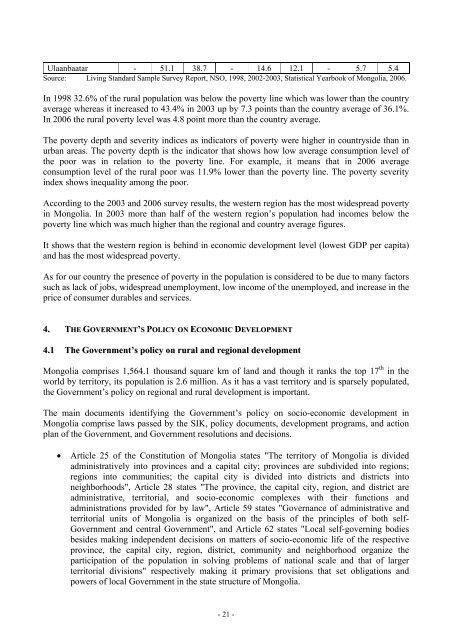LOCAL ECONOMIC DEVELOPMENT DESK STUDY
LOCAL ECONOMIC DEVELOPMENT DESK STUDY
LOCAL ECONOMIC DEVELOPMENT DESK STUDY
Create successful ePaper yourself
Turn your PDF publications into a flip-book with our unique Google optimized e-Paper software.
Ulaanbaatar - 51.1 38.7 - 14.6 12.1 - 5.7 5.4<br />
Source: Living Standard Sample Survey Report, NSO, 1998, 2002-2003, Statistical Yearbook of Mongolia, 2006.<br />
In 1998 32.6% of the rural population was below the poverty line which was lower than the country<br />
average whereas it increased to 43.4% in 2003 up by 7.3 points than the country average of 36.1%.<br />
In 2006 the rural poverty level was 4.8 point more than the country average.<br />
The poverty depth and severity indices as indicators of poverty were higher in countryside than in<br />
urban areas. The poverty depth is the indicator that shows how low average consumption level of<br />
the poor was in relation to the poverty line. For example, it means that in 2006 average<br />
consumption level of the rural poor was 11.9% lower than the poverty line. The poverty severity<br />
index shows inequality among the poor.<br />
According to the 2003 and 2006 survey results, the western region has the most widespread poverty<br />
in Mongolia. In 2003 more than half of the western region’s population had incomes below the<br />
poverty line which was much higher than the regional and country average figures.<br />
It shows that the western region is behind in economic development level (lowest GDP per capita)<br />
and has the most widespread poverty.<br />
As for our country the presence of poverty in the population is considered to be due to many factors<br />
such as lack of jobs, widespread unemployment, low income of the unemployed, and increase in the<br />
price of consumer durables and services.<br />
4. THE GOVERNMENT’S POLICY ON <strong>ECONOMIC</strong> <strong>DEVELOPMENT</strong><br />
4.1 The Government’s policy on rural and regional development<br />
Mongolia comprises 1,564.1 thousand square km of land and though it ranks the top 17 th in the<br />
world by territory, its population is 2.6 million. As it has a vast territory and is sparsely populated,<br />
the Government’s policy on regional and rural development is important.<br />
The main documents identifying the Government’s policy on socio-economic development in<br />
Mongolia comprise laws passed by the SIK, policy documents, development programs, and action<br />
plan of the Government, and Government resolutions and decisions.<br />
• Article 25 of the Constitution of Mongolia states "The territory of Mongolia is divided<br />
administratively into provinces and a capital city; provinces are subdivided into regions;<br />
regions into communities; the capital city is divided into districts and districts into<br />
neighborhoods", Article 28 states "The province, the capital city, region, and district are<br />
administrative, territorial, and socio-economic complexes with their functions and<br />
administrations provided for by law", Article 59 states "Governance of administrative and<br />
territorial units of Mongolia is organized on the basis of the principles of both self-<br />
Government and central Government", and Article 62 states "Local self-governing bodies<br />
besides making independent decisions on matters of socio-economic life of the respective<br />
province, the capital city, region, district, community and neighborhood organize the<br />
participation of the population in solving problems of national scale and that of larger<br />
territorial divisions" respectively making it primary provisions that set obligations and<br />
powers of local Government in the state structure of Mongolia.<br />
- 21 -

















